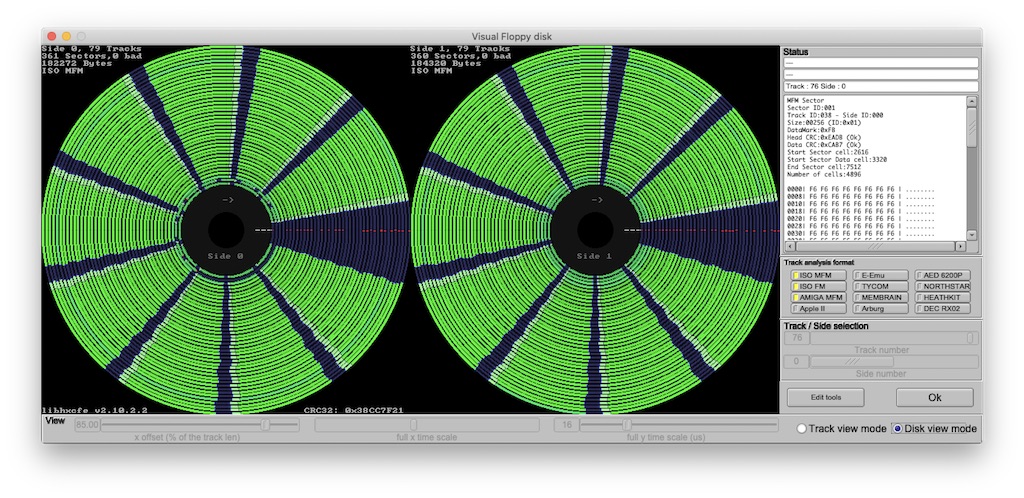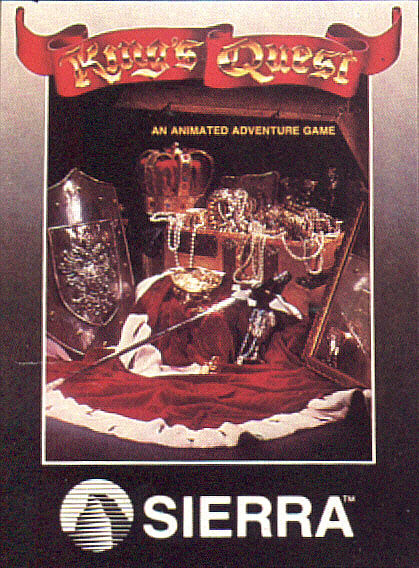PCjs Machines
Home of the original IBM PC emulator for browsers.

King's Quest (1985)
According to Nerdly Pleasures, the 1985 releases of King’s Quest were for the Tandy 1000 and IBM PCjr. These releases were also known as “PC Booter” editions, because you use Disk 1 as a boot disk to start the machine, which in turn starts the game.
The PCjs disk images preserve the Copy-Protection that the game used, and PCx86 successfully passes the game’s copy-protection test.
However, since PCx86 does not yet support the graphics hardware in those machines, you cannot currently play those releases here. Once that support is added, we’ll remove the PCjs Debugger from this page and update this notice.
[PCjs Machine "ibm-5160-cga"]
Waiting for machine "ibm-5160-cga" to load....
Copy-Protection
This version of King’s Quest (from archive.org) seemed like a good copy-protection candidate to examine, because it came with a complete set of Kryoflux files (along with an IMG file) for each of the game’s two 360K diskettes.
The Kryoflux RAW files included 84 tracks of data for each diskette, even though these were 40-track diskettes, so I moved all the odd-numbered tracks (and tracks >= 80) into a tmp directory, loaded the 40 remaining even-numbered tracks in the HxC Floppy Emulator, saved the data as a new IMG file, and then compared the resulting IMG file to the one included with the download.
They were identical, up until offset 0x55800 (350208). If we divide that by 4608 (the number of bytes in a normal 9-sector track), we get 76, which corresponds to track 38 on side 0. And when I examined the tracks visually in the HxC Floppy Emulator, using “Disk view mode”, I could see that track 38 contained 10 256-byte sectors; in addition, the first sector ID was 1, whereas all the other 9 sector IDs were 0.

Next, just as I did for Microsoft Adventure, I wanted to create a PSI (“PCE Sector Image”) representation of the disk, since I already have some tools that understand PSI files.
To quickly recap, here are the basic steps, using tools from PCE:
- From the Kryoflux RAW files, create a PFI (“PCE Flux Image”) file
- Next, create a PRI (“PCE Raw Image”) file, with the flux reversal pulses converted to bits
- From the PRI file, create a PSI (“PCE Sector Image”) file
- From the PSI file, create a JSON-encoded disk image file, using the PCjs
diskdumputility
which translates to these commands:
pfi KINGS_QUEST1-DISK1.00.0.raw disk1.pfi
pfi disk1.pfi -p double-step -r 600000 -p decode pri disk1.pri
pri disk1.pri -c 40-99 -p delete disk1.pri
pri disk1.pri -p decode mfm disk1.psi
diskdump --disk=disk1.psi --format=json --output=disk1.json
NOTE: Prior to running the above PCE utilities, I put all the odd-numbered Kryoflux RAW track files back with the even numbered ones, to avoid any confusion.
Now, the first step (creating a PCE Flux Image file) is optional, because you can actually create a PRI file directly from the RAW files:
pfi KINGS_QUEST1-DISK1.00.0.raw -p double-step -r 600000 -p decode pri disk1.pri
but it’s nice to have the PCE flux representation of the diskette in a single PFI file as well, because then you can use the PFI utility
to display image information (pfi disk1.pfi -p info), track information (pfi disk1.pfi -l), and more (see pfi --help).
Similarly, the PSI utility has some handy display options (eg, psi disk1.psi -L).
Debugging Notes
The following disk operations were observed after turning on the PCjs Debugger’s FDC (Floppy Disk Controller) messages (m fdc on):
FDC initialized for 4 drive(s)
fdcNEC.doRead(drive=0,CHS=0:0:1,PBA=0,addr=0x7c00)
fdcNEC.doRead(drive=0,CHS=0:0:2,PBA=1,addr=0x7dba)
fdcNEC.doRead(drive=0,CHS=0:0:6,PBA=5,addr=0x7dba)
fdcNEC.doRead(drive=0,CHS=0:1:4,PBA=12,addr=0x9f3f0)
fdcNEC.doRead(drive=0,CHS=0:1:5,PBA=13,addr=0x9f5f0)
fdcNEC.doRead(drive=0,CHS=0:1:6,PBA=14,addr=0x9f7f0)
fdcNEC.doRead(drive=0,CHS=0:0:2,PBA=1,addr=0x9f9ba)
fdcNEC.doRead(drive=0,CHS=0:0:6,PBA=5,addr=0x9fdba)
fdcNEC.doRead(drive=0,CHS=0:1:8,PBA=16,addr=0x600)
fdcNEC.doRead(drive=0,CHS=1:0:1,PBA=18,addr=0xa00)
fdcNEC.doRead(drive=0,CHS=1:1:1,PBA=27,addr=0x1c00)
fdcNEC.doRead(drive=0,CHS=2:0:1,PBA=36,addr=0x2e00)
fdcNEC.doRead(drive=0,CHS=2:1:1,PBA=45,addr=0x4000)
fdcNEC.doRead(drive=0,CHS=3:0:1,PBA=54,addr=0x5200)
fdcNEC.doRead(drive=0,CHS=3:1:1,PBA=63,addr=0x6400)
fdcNEC.doRead(drive=0,CHS=4:0:1,PBA=72,addr=0x7600)
fdcNEC.doRead(drive=0,CHS=0:1:2,PBA=10,addr=0x693)
fdcNEC.doRead(drive=0,CHS=38:0:0,PBA=683,addr=0xf000)
That last read occurs when the game executes this code:
&0060:4D28 33D2 XOR DX,DX
&0060:4D2A 32C9 XOR CL,CL
&0060:4D2C 8A2E4C1E MOV CH,[1E4C]
&0060:4D30 8B1E2F10 MOV BX,[102F]
&0060:4D34 8EC3 MOV ES,BX
&0060:4D36 33DB XOR BX,BX
&0060:4D38 C6064B1E03 MOV [1E4B],03
&0060:4D3D B001 MOV AL,01
&0060:4D3F B402 MOV AH,02
&0060:4D41 CD13 INT 13
which requests sector ID 0 from track 38. But, as noted above, there nine sectors on that track with a sector ID of 0. And originally, PCx86’s simplistic seek() logic would always return the first sector with a matching ID on the desired track. However, as the Nerdly Pleasures blog pointed out, this copy-protection scheme relies on the controller returning whichever sector happened to be next, and depending on timing, that will not always be the first such sector on the track.
I resolved this problem by having the FDC drive object maintain a cached reference to the last sector read (or written) on that drive, which is then passed to the Disk component’s seek() function. If the previous sector matches the next candidate sector, then the rest of the track is checked for any other candidate sectors with the same sector ID, and if such a sector is found, that sector is selected instead.
That appears to have resolved the copy-protection issue. The next hurdle is now adding support for the graphics mode the game uses.
Online References

Directory of King’s Quest (1985-09-04 #2)
Volume in drive A has no label
Directory of A:\
LOAD * 1482 6-19-84 11:14a
MAIN EXE* 28868 9-04-85 10:16p
2 file(s) 30350 bytes
330752 bytes free